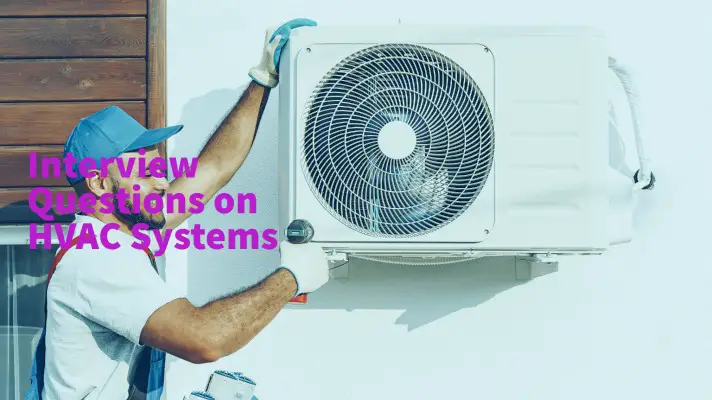Hello dear all! In this article, I will display some Interview Questions on HVAC System. HVAC System means Heating, Ventilation, Refrigeration, and Air-Conditioning System. The interview questions will be displayed in the form of Multiple-Choice Questions, Short Questions as asked by the Interviewers.
Now, the question may arise in your mind why shall I display the interview questions only on the HVAC system? The answer to this question is that I am having 9 years of Industry Experience in HVAC systems.
So without wasting your time, let’s start the Interview Questions. First, I will display some MCQ Questions on HVAC Systems.

Interview Questions or MCQ Questions on HVAC System
- The full form of VRF system is:
- Variable refrigerant frequency
- Variable refrigerant fluid
- Variable refrigerant flow
- None of the above
Ans: (3)
- VRF system is capable to handle
- Latent heat
- Sensible heat
- Both of the above
Ans: (2) VRF system is capable to handle 70% to 80% of Sensible heat and 20%-30% Latent heat.
- Cooling tower is designed based on:
- Dry bulb temperature
- Wet bulb temperature
- Wind speed
- None of the above
Ans: (2)
- For battery room ventilation, what type of fans are used?
- Tube-axial fans for supply and exhaust
- Centrifugal fans for supply only
- Only Exhaust fan
- Tube-axial fan only for supply
Ans: (3)
- What is ACPH?
- Air changes per hour
- Amount of air circulated inside a zone
- None of these
Ans: (1)
- For battery room ACPH is:
- 5
- 15-20
- 50-80
- Less than 5
Ans: (2)
- Based on which temperature Evaporative cooling type ventilation system is designed?
- Dry bulb temperature
- Dry bulb depression
- Wet-bulb temperature
- None of these
Ans: (3)
- Why fire dampers are provided when duct crosses any wall/roof?
- To stop spreading the fire from one room to another.
- To stop the flow of air path to the adjacent rooms
- Both (1) and (2)
- None of these.
Ans: (3)
- Which of the following design criteria, you should follow while designing a battery room ventilation system?
- The room should be negative pressurized.
- The room should be positive pressurized.
- The ACPH should be 1.
- None of the above.
Ans: (1)
- Generally SWAS Dry panel area should be:
- Ventilated normally with supply and exhaust fans
- Air-conditioned
- Should be ventilated for maintaining negative pressure.
- None of these
Ans: (2)
- How much ACPH will you consider for calculating the fresh air required for maintaining the air-conditioning system?
- 20-25
- 15-20
- 5-10
- 1-1.5
Ans: (4)
- How much fresh air you should consider for a person while calculating the heat load of an office area?
- 30-35 CMH
- 30-35 CFM
- 3-5 CMH
- 3-5 CFM
Ans: (1)
- All galvanised carbon steel ductwork shall conform to:
- IS:1239
- IS:655
- IS:3589
- IS:2062
Ans: (2)
- For pipes up to 150 NB, piping material shall be as per:
- IS:1239
- IS:655
- IS:3589
- IS:2062
Ans: (1)
- For pipes 200NB and above, piping material shall be as per:
- IS:1239
- IS:655
- IS:3589
- IS:2062
Ans: (3)
- Which one of the following valves will you choose for isolating purposes?
- Butterfly valve of size 80NB and above
- Gate valve of size below 80 NB
- Both (1) and (2)
- Globe valve
Ans: (3)
- What is the unit of fouling factor?
- Hr.W/m.k
- Kcal.0c/hr.sqm.
- Hr.sqm. 0c/kcal
- Hr.sqm.w/0c
Ans: (3)
- Which one of the following is true for calculating heat load for an Air-conditioned area?
- Fouling factor for evaporator 0.00013 and for condenser 0.002 Hr.sqm. 0c/kcal
- Fouling factor for condenser 0.00013 and for evaporator 0.002 Hr.sqm. 0c/kcal
- Fouling factor for both evaporator and condenser are 0.00013 Hr.sqm. 0c/kcal
- Fouling factor for both evaporator and condenser are 0.002 Hr.sqm. 0c/kcal
Ans: (1)
- For heat load calculation, generally, lighting load should be considered as:
- 1-5 W/sq.m
- 5-10 W/sq.m
- 15-20 W/sq.m
- 30-40 W/sq.m
Ans: (3)
- For water line valves of cast iron body, you should follow:
- IS:3589
- IS:2062
- IS:210
- IS:655
Ans: (3)
Short Questions on HVAC System:
What is air-conditioning?
Ans: Air conditioning is a process by which one can control the temperature and humidity for maintaining the comfort level of human beings as well as of equipment.
1 TR = ______________ BTU/Hr = ___________ Kw
Ans: 12,000 and 3.5
What are the steps for heat load calculation?
Ans: First collect the input data such as outdoor design condition and indoor design condition, civil details (wall, rooms, floor, roof, false-ceiling and true-ceiling details), room dimensions, the orientation of the building/room, equipment heat load, lighting load, occupancy details.
Next, find out the sun-gain for the glasses, temperature differences for the walls, floors, and roofs. Calculate fresh air quantity. Next, calculate the sensible heat for the glasses, walls, floors, and roofs due to outside air. Get the room total sensible heat by adding those with the sensible load due to occupancy, lighting, and equipment. Consider 10% margin and get RTSH.
For designing the AHU, you need to consider this heat load. So,
AHU CFM = RTSH/(1.08*(1-BF)*(Room temp-ADP)) = dehumidified air quantity
ADP- Apparatus dew point-select from ISHRAE Handbook. And CFM is cubic feet/minute.
Then calculate sensible and latent heat gain due to outside air and add those to get outside air total heat gain (OATH). Next, calculate the latent heat due to occupancy and fresh air. Add those to get room latent heat. Consider a 10% margin to get room total latent heat (RTLH).
RTH (Room total heat) = (RTSH+ RTLH)
GTH (Grand Total Heat) = RTH+OATH+RAHG
RAHG- Return air heat gain (including AHU Room heat gain if any).
Tonnage (TR) = (GTH/12,000)
What are the inputs you require for heat load calculation?
Ans: Outdoor design condition and indoor design condition, civil details (wall, rooms, floor, roof, false-ceiling and true-ceiling details), Room dimensions, the orientation of the building/room, equipment heat load, and lighting load, occupancy.
How to calculate the capacity of Pan Humidifier & Strip Heater?
Ans: Pan humidifier capacity = [(Fresh air qty *0.68* (grain/lboutside– grain/lbinside)winter)/3400]kw
Strip heater capacity =
(RTSHsummer – RTSHmonsoon)/3400 kw
What is free cooling?
Ans: In winter, there is no requirement of reducing temperature. Hence in a central air conditioning system, during winter the cooling coil does not run. This is known as free cooling.
What is TFA unit? Why it is used?
Ans: TFA is a Treated fresh air unit. In some high-rise buildings, TFAs are located on roofs. The fresh air enters through these units and gets treated with the help of some amount of return air. As a result, the fresh air temperature is reduced and the load is decreased.
Why & where secondary chilled water pumps are used?
Ans: Chilled water of 5-7 Degree C is supplied to the AHU unit and is returned to the Chiller (11-12 Degree C) by Primary chilled water pumps.
In some cases, regulating the chilled water flow is needed to meet the requirement. These systems are known as the Primary-secondary systems. In these cases, chilled water is also supplied through pumps to the AHU Rooms and these pumps are called secondary pumps.
What do mean by by-pass factor? If bypass factor increases, what will happen?
Ans: The full mixture of room air and fresh air should pass through the cooling coil of AHU. But in reality, 100% does not pass through the cooling coil. Some amount of air is bypassed that increasing the cooling load. This is known as the bypass factor. When the bypass factor increases, the cooling load increases.
What are the type of insulation (density & thickness) used for chilled water pipes & AC ductwork?
Ans: Depending on the thickness of the insulation, it can be of three types: 8-10 inches; 10-12 inches, and more than 12 inches.
The insulation materials mainly used are cellulose, fiberglass, and mineral wool.
Calculation of Insulation thickness:
Say, the radius of the pipe is Rp, and the radius of insulation is Ri.
The temperature of the fluid inside the pipe is Tp and the desired temperature on the external side of the insulation is Ti. The length of the pipe is N and the thermal conductivity of the insulating material is k.
Applying Fourier’s law, heat transferred,
Q =2πk.N(Tp-Ti) /ln(Ri/Rp)
If you know the heat transferred per unit length, i.e Q/N, then from the above formula, you will get Ri. You know Rp. So, you can calculate the thickness of insulation as (Ri-Rp).
Conclusion
I hope that you like the Interview Questions on HVAC Systems along with the short questions and it will help you in clearing the interviews. Best Wishes!


